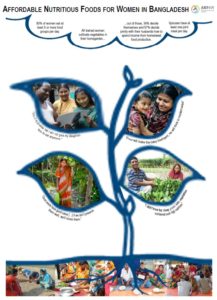GIZ Division: Agricultural Policy, Food Security, Sustainable Use of Resources
Project Location: Nilpharmari, Rangpur Division, Bangladesh
Target Group: Women of reproductive age of smallholder farming households
Duration: January 2014 – May 2017
Gender-related Country Facts:
• Nearly half of female adolescents aged between 15-19 years (45%) are married in comparison to
only 2% of their male counterparts
• One fourth of ever-married women aged 15-49 years (24%) are undernourished
(Body Mass Index < 18.5)
• Less than half of currently married women (42%) participate in all four decisions regarding their
own health care, major household purchases, child health care, and visits to their family or relatives
• About one-third of currently married employed women in rural areas (32%) who earn cash make
decisions mainly by themselves on how to use their own earnings
(Data from Bangladesh Demographic and Health Survey 2011 and 2014)
Gender-specific Project Activities:
• Training of women on homestead food production and family nutrition
• Promotion of micronutrient rich crops
• Gender-sensitive nutrition training of men and women
• Nutrition communication campaign
Achieved Genderrelated Results:
• All women cultivate vegetables in their homegarden. Diversity (8 and 4 varieties, respectively) and
amount (27kg and 13 kg, respectively) of production of ANF4W trained women was more than
twice as much as of non-trained women. Out of trained women 34% decide themselves and 57%
jointly with their husband how to spend income from their homestead food production
• 68% of trained women perceived that wife and husband jointly decide on major household
expenditures compared to only 26% of women in control area
• 80% of women of reproductive age achieved minimum dietary diversity
• Almost 100% of husbands and wives took at least one meal together per day
Results Monitoring System:
Results model includes gender-specific milestones and indicators
• Women’s dietary diversity
• Joint meals
• Intra-household decision making and power relations
• Nutrition-related awareness raising of men and women
Data collection through bi-monthly field visits, activity monitoring, and randomized household surveys at
baseline, midline, and endline

 GIZ Gender Website
GIZ Gender Website